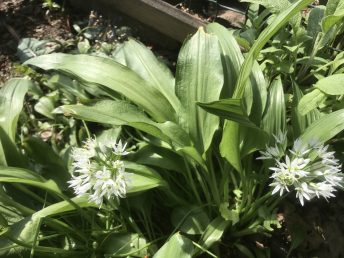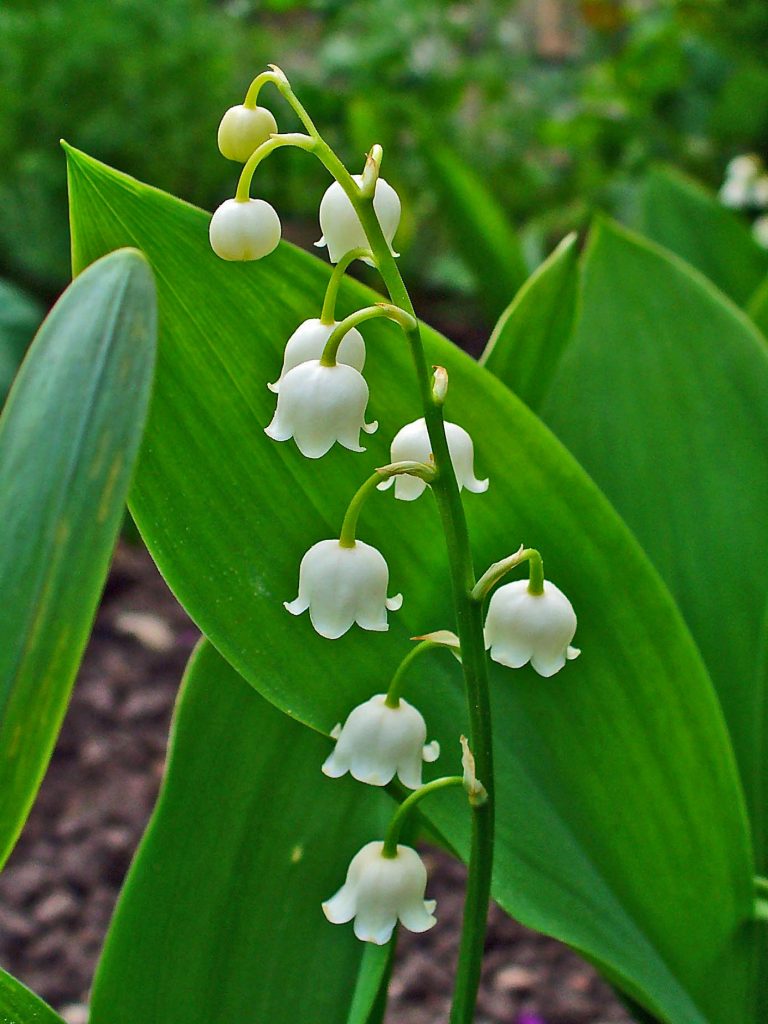Disclaimer: All our information is provided solely as guidance, and is not guaranteed to be correct (though we have tried to ensure it is). You must check and cross-check information before eating anything you find outside. We accept no responsibility for any consequences arising from information contained here – it is your responsibility to check that what you are eating is safe.
Wild Garlic, also known as ramson, bear garlic or wood garlic is a common wild edible plant. It grows in shady, damp woods, and can sometimes be found near Lily of the Valley, which is poisonous – eating it can result in death. Ramsons have a distinctive, garlicky smell – but if you’re unsure, don’t eat it. Wild garlic and Lily of the Valley also have entirely different flowers. Ramsons have upward-pointing clusters, and lily of the valley has hanging bells. Mercifully, lily of the valley are less common in the UK than proper ramson.

Ramson 
Lily of the Valley
This may seem a scary introduction, but it is well worth working out which is which. Ramsons can add a delicious taste to almost any dish – at home, try making a ramson and bacon quiche, or ramson soup.
This website is devoted to the outdoors, so I’ll focus on more camp-friendly things to do with this tasty natural foodstuff.
What you do with your ramsons depends entirely on what sort of trip you’re doing. If you’re backpacking, it’s unlikely that you plan on cooking up a massive feast every night, for example. I’m going to divide the rest of this article into two sections: one for backpacking, and the other for semi-bushcraft.
Backpacking Uses for Wild Garlic
When on backpacking trips, I normally have wraps with some form of sweet or savoury (energy-dense) filling such as nutella or cheese for lunch. If you think you might be able to collect ramsons, try a cheddar and ramson wrap. This is great as both cheddar and wraps will keep for a long time in your pack, and ramsons are a good way to add some freshness to your lunch.
Another great use for wild garlic is to chop it finely and mix into your sauces (I normally have rice or pasta with a simple sauce in the evenings). For best results, chop the ramsons into your sauce at least 10 minutes before you plan to eat, because this gives the flavours time to properly infuse. Make sure not to add too much (2-3 leaves), because fresh ramsons have an extremely strong taste, especially when allowed to infuse.
‘Bushcraft’ Uses for Wild Garlic
By ‘Bushcraft’ I don’t mean full-on wilderness survival. If you’re planning on that sort of trip, you should already know about most wild edibles. What I mean here is if you’re planning to spend some time in the woods in a more improvised shelter and campfire cooking, but still planning to carry most of your food with you. It can be a nice balance to carry most of your food, then forage for extra flavour.
My favourite things to do with wild garlic in these sort of scenarios are simple:
Mayonnaise can be a delicious addition to many (especially meaty) dishes, so if you have brought mayonnaise, try infusing it with wild garlic. Again, chop a few leaves finely and add them to the mayonnaise, then leave to infuse.
You can then use the ramson mayonnaise to make a warm potato salad: simply boil up some potatoes and drain, then mix with the mayonnaise. It can also be nice to add some other greens to this mix – parsley or chives work particularly well.
If you’re planning to roast or slow-cook meat in a dutch oven, you can flavour it with wild garlic too, or add it to a stew.
Conclusion
Cooking with wild garlic is extremely easy, and the best way to find out what works is just by trying things out. Obviously using all of my suggestions at once would be far too much.



